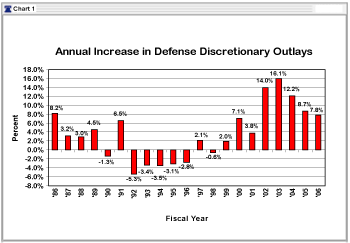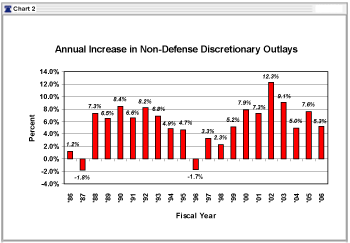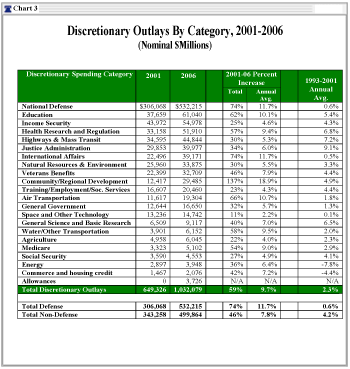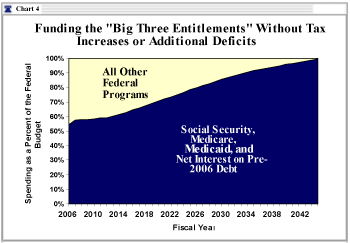My name is Brian Riedl. I am the Grover M. Hermann Fellow in Federal Budgetary Affairs at The Heritage Foundation. The views I express in this testimony are my own, and should not be construed as representing any official position of The Heritage Foundation.
Discretionary spending is not out of the line with historical trends. However, budget increases since 2001 have set this spending on a steeply upward course just as escalating entitlement costs are putting an enormous strain on the entire budget.
Historical Context
The 7.9 percent of GDP spent on discretionary programs in 2005 was not far off the historical average. Discretionary spending topped 10 percent of GDP from World War II through the early 1980s, before falling to 6.3 percent in 2000, and then spiking back up to 7.9 percent in 2005.
Defense spending has driven much of these fluctuations. From 9.3 percent of GDP in 1962, it typically remained over 5 percent until the Soviet Union fell in 1991. Then, after dropping all the way down to 3.0 percent of GDP in 2000, the War on Terrorism has pushed it back up to 4.1 percent.
Non-defense discretionary spending has remained more stable over the past few decades. After dropping to 3.2 percent of GDP in 1999, it has since surged to 3.9 percent in 2005.
Recent Large Spending Increases
Conventional wisdom holds that non-defense discretionary spending has been cut to make room for defense spending increases. Conventional wisdom is wrong. According to OMB Historical Table 8.2, non-defense discretionary outlays - adjusted for inflation -surged by 34 percent between 1999 and 2005. That is the largest six-year expansion since the 1970s.
One way to compare current discretionary spending trends is by presidential administration:
Overall discretionary outlays rose 2.3 percent annually under President Clinton, compared to 9.7 percent annually under President Bush. Defense was virtually frozen in nominal dollars under President Clinton, and has averaged 12 percent annual growth under President Bush. Non-defense discretionary outlays rose 4 percent annually under President Clinton, versus 8 percent annually under President Bush.
Let me re-emphasize that last point: Non-defense discretionary spending has grown twice as fast under President Bush as under President Clinton. Examples of discretionary spending increases between 2001 and 2006 include the following:
Education is up 62 percent, or 10 percent annually; International affairs is up 74 percent, or 12 percent annually; Health research and regulation is up 57 percent, or 9 percent annually; Veterans' benefits are up 46 percent, or 8 percent annually; Science and basic research is up 40 percent, or 7 percent annually. and Overall non-defense discretionary outlays are up 46 percent, or 7.8 percent annually.
Budgets are about making trade-offs among competing priorities, and these recent guns and butter budgets raise serious questions about federal priorities. To enact the largest six-year non-defense discretionary spending hike, at the same time funding a war, has placed federal spending on an unsustainable path. Last week's harsh reactions to the President's budget proposal shows that certain constituencies have now grown accustomed to large annual spending increases, and consider even a temporary freeze at these higher spending levels to be out of bounds.
Large Entitlements Threaten Discretionary Programs
Discretionary spending faces a perilous future. The reason is not because the President's budget proposal forecasts discretionary spending cuts through 2011. Discretionary spending is budgeted on a yearly basis, and any projected discretionary spending numbers after 2007 hold no statutory weight, but serve only as temporary placeholders to make future budget deficits appear smaller. These out-year numbers are typically dismissed by the White House when writing subsequent budget requests.
The real reason for concern comes from Social Security, Medicare, and Medicaid, whose steep growth will likely crowd out all other spending.
The math is simple. Annual spending on Social Security, Medicare, and Medicaid - what I call the "big three entitlements" - is projected to leap by 10.5 percent of GDP between now and 2050. That money will have to come from somewhere. The entire 7.9 percent of GDP currently spent on discretionary programs will be at risk.
It is possible that Congress will raise taxes to pay for this spending. However, Congress would have to keep raising taxes every year until they reach the current equivalent of $11,000 per household above current levels to fund those entitlement costs.
Assuming that Congress balks at such large tax hikes, it becomes more likely that discretionary spending will have to be substantially reduced to make room for those entitlements. Competition for scarce budget resources will become increasingly intense, and the big three entitlements will leave smaller and smaller crumbs for discretionary spending. Overall, Social Security, Medicare, and Medicaid spending increases are projected to squeeze out the entire non-defense discretionary budget by 2020, and the entire discretionary budget (including defense) by 2034.
The message is clear: If you prioritize spending on education, health research, veterans' health care, homeland, security, defense or the environment - the single biggest threat to these programs is Social Security, Medicare, and Medicaid. The Congressional Budget Office estimates that within a decade, the big three entitlements will be growing $172 billion each year - which will be more than the entire combined budgets of the Departments of Education and Justice at that time. At that point, it will become difficult to maintain even a shell of current discretionary programs. Social Security, Medicare, and Medicaid will swallow almost all of the tax dollars.
The Heritage Foundation is creating a budget calculator that allows lawmakers to work with the long-term tax and spending baselines, and test different scenarios to cover these long-term entitlement shortfalls. We would be happy to bring this program to your offices.
Reform
While Congress' top domestic priority should be reforming Social Security, Medicare, and Medicaid, they should also seize this opportunity to take a fresh look at discretionary spending growth. For example, education, housing, and transportation, are traditionally state and local functions, and may be devolved again. Many of these federal programs currently force Americans to pay large taxes to Washington, who shave some administrative costs, and then send the money right back to state and local governments with new strings attached. It may be more efficient, more democratic, and less costly to bypass the federal middleman and have taxpayers send the taxes for these programs directly to local governments who can tailor these programs to local needs. This would allow Congress to focus more on key national issues such as national security. A federal government that tries to do everything, risks succeeding at little.
Congress should also consider creating a commission, similar to the successful BRAC model that closed obsolete military bases, to package all outdated, wasteful, and unnecessary programs into one termination bill that would receive expedited floor consideration. This could reduce some of the enormous waste in the federal budget.
At that very least, basic budget caps can help lawmakers set priorities and make trade-offs. Congress should consider attaching these caps to the debt limit vote later this month.
View Archived Webcast of this hearing
Appendix:


Source: Both charts come from the Office of Management and Budget, Historical Tables, Budget of the United States Government, Fiscal Year 2007 (Washington, D.C.: U.S. Government Printing Office, 2006), Table 8.1, at http://www.whitehouse.gov/omb/budget/fy2007/hist.html.

-
From 2001 through 2006, inflation will have totaled 12 percent, and the population will have grown 5 percent.
-
2006 numbers reflect current OMB estimates. Additional supplemental spending will add to this total.
-
Source: Office of Management and Budget, Historical Tables, Budget of the United States Government, Fiscal Year 2007 (Washington, D.C.: U.S. Government Printing Office, 2006), Table 8.1. at: http://www.whitehouse.gov/omb/budget/fy2007/hist.html.

The Heritage Foundation is a public policy, research, and educational organization recognized as exempt under section 501(c)(3) of the Internal Revenue Code. It is privately supported and receives no funds from any government at any level, nor does it perform any government or other contract work.
The Heritage Foundation is the most broadly supported think tank in the United States. During 2013, it had nearly 600,000 individual, foundation, and corporate supporters representing every state in the U.S. Its 2013 income came from the following sources:
Individuals 80%
Foundations 17%
Corporations 3%
The top five corporate givers provided The Heritage Foundation with 2% of its 2013 income. The Heritage Foundation’s books are audited annually by the national accounting firm of McGladrey, LLP.
Members of The Heritage Foundation staff testify as individuals discussing their own independent research. The views expressed are their own and do not reflect an institutional position for The Heritage Foundation or its board of trustees.
